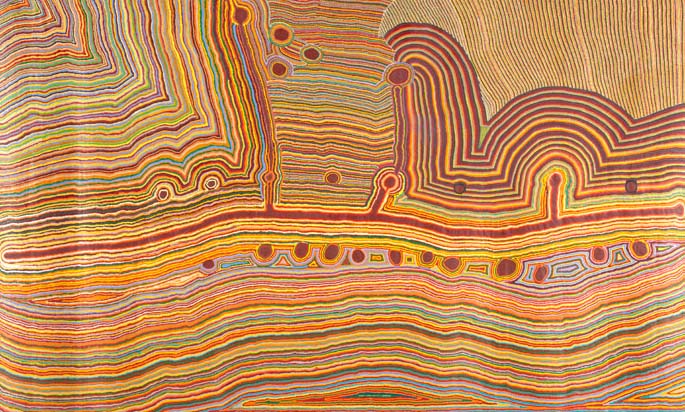
Martulimi Artists, Martumili Ngurra, 2009, acrylic on linen, 509 x 320 cm. Courtesy National Museum of Australia, Canberra, Australia
Iconic Canning Stock Route paintings tour Japan
Iconic Indigenous paintings from the National Museum of Australia’s Canning Stock Route collection go on display in Japan today, at the start of a major international tour of a jewel in the crown of the institution’s National Historical Collection.
One Road: Aboriginal Art from Australia’s Deserts opens at the National Museum of Ethnology in Osaka today for a six-week exhibition, before moving to Kagawa Prefecture Museum, Kawaga, followed by Ichihara Lakeside Museum, Chiba, Tokyo and finally Kushiro City Museum of Art, Hokkaido.
One Road features thirty-four paintings drawn from the Canning Stock Route collection and includes works by Australia’s most renowned Aboriginal artists. These include Rover Thomas, Patrick Tjungurrayi, Eubena Nampitjin, Jan Billycan, Jackie Giles and Helicopter Tjungurrayi.
The exhibition explores the history of the famous West Australian droving road (the Canning Stock Route) through the stories of the country it cuts across. Drawing on the works of desert artists and the stories of traditional custodians, the exhibition tells the story of the Canning Stock Route’s impact on Aboriginal people, and the importance of the country surrounding it.
The One Road paintings were inspired by a six-week return-to-country trip in 2007.
The exhibition reflects ongoing Japanese interest in Indigenous art after the National Museum’s successful Utopia: The Genius of Emily Kame Kngwarreye exhibition toured Japan in 2008.
National Museum Director Dr Mathew Trinca said he was excited that Japanese audiences will have the opportunity to see such unique works.
“The original Canning Stock Route exhibition toured Australia from 2010-13 to record numbers and we are delighted to be able to take this stunning and important show to a global audience,” said Dr Trinca.
“One Road will make an important contribution to international understanding of Australia’s complex history and the intersection of Indigenous and non-Indigenous experience,” said Dr Trinca.
The exhibition is based on Yiwarra Kuju: The Canning Stock Route, the most successful exhibition staged by the National Museum of Australia in Canberra, developed by the National Museum of Australia and FORM, which toured Australia from 2010 to 2013.
About the Canning Stock Route
The Canning Stock Route is the longest historic stock route in the world. Late 19th century industrial expansion in Western Australia sparked the need for stock routes allowing cattle to be moved from stations in the north to markets in the south. First surveyed in 1906 by Alfred Canning, the route comprised 48 wells spaced at intervals of no more than one day’s walk, along an 1800 kilometre stretch of track. The route links Wiluna in the south with Sturt Creek in the north and traverses the traditional lands of nine Aboriginal language groups.
Although Canning’s original map records observations of the land and water resources, it makes no mention of Indigenous places through which the route traversed or their associated meanings.
The development of the ultimately unsuccessful cattle route dramatically affected the lives of Aboriginal people. The National Museum’s collection is the first significant attempt to document the Aboriginal experience of the Canning Stock Route. The collection redresses Canning’s omission and records the impact of the stock route on Indigenous lives and country.
JAPAN TOUR DATES:
•National Museum of Ethnology, Osaka – 9 June to 19 July 2016
•Kagawa Prefecture Museum, Kawaga – 5 August to September 2016
•Ichihara Lakeside Museum, Chiba, Tokyo – 1 October 2016 to January 2017
•Kushiro City Museum of Art, Hokkaido – April to May 2017
SOURCE:
National Museum Australia ’s website
ARTICLE:
Rachel Mealey, Indigenous art exhibition of Canning Stock Route collection works launches Japanese tour in Osaka, ABC, 14 June 2016